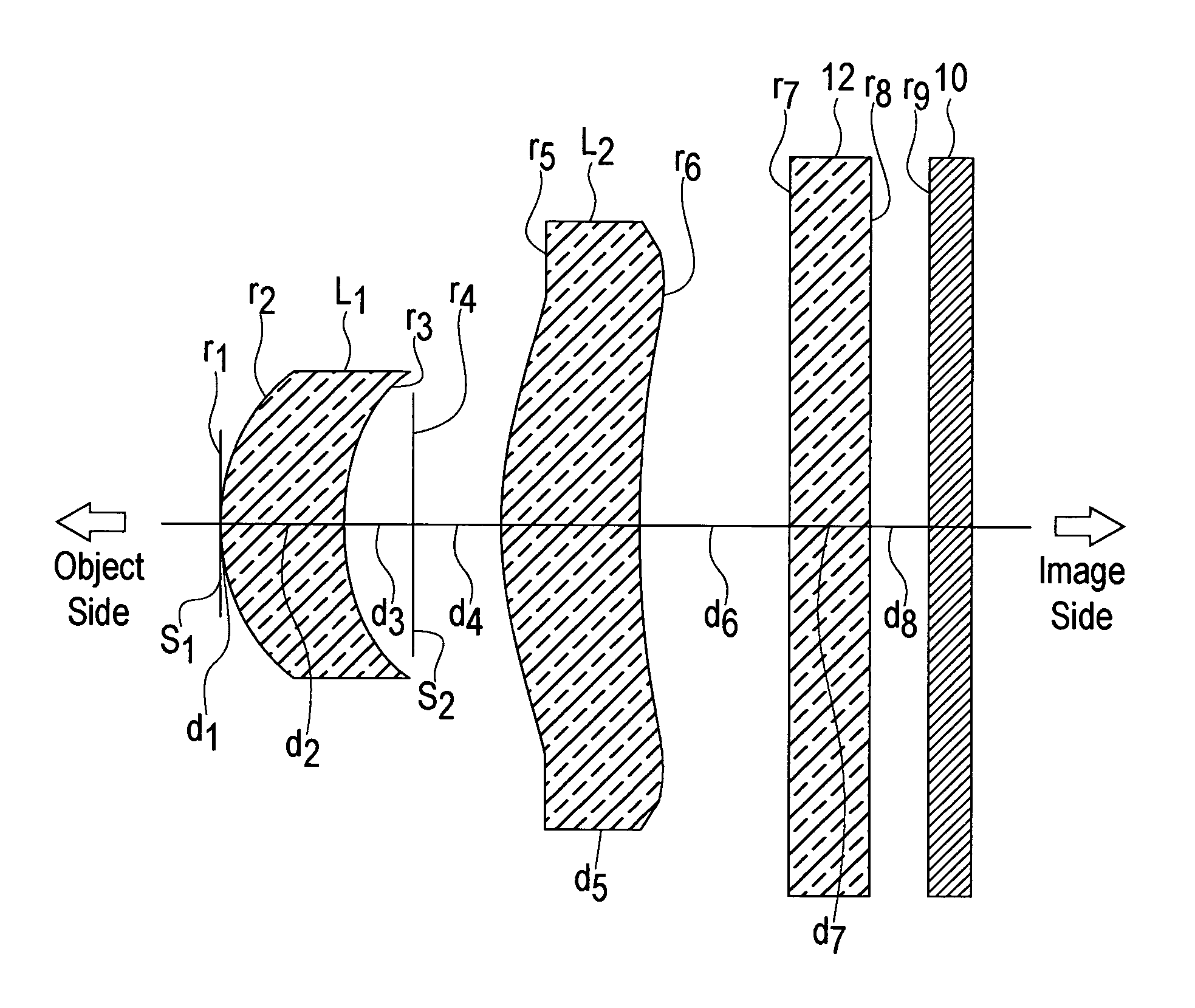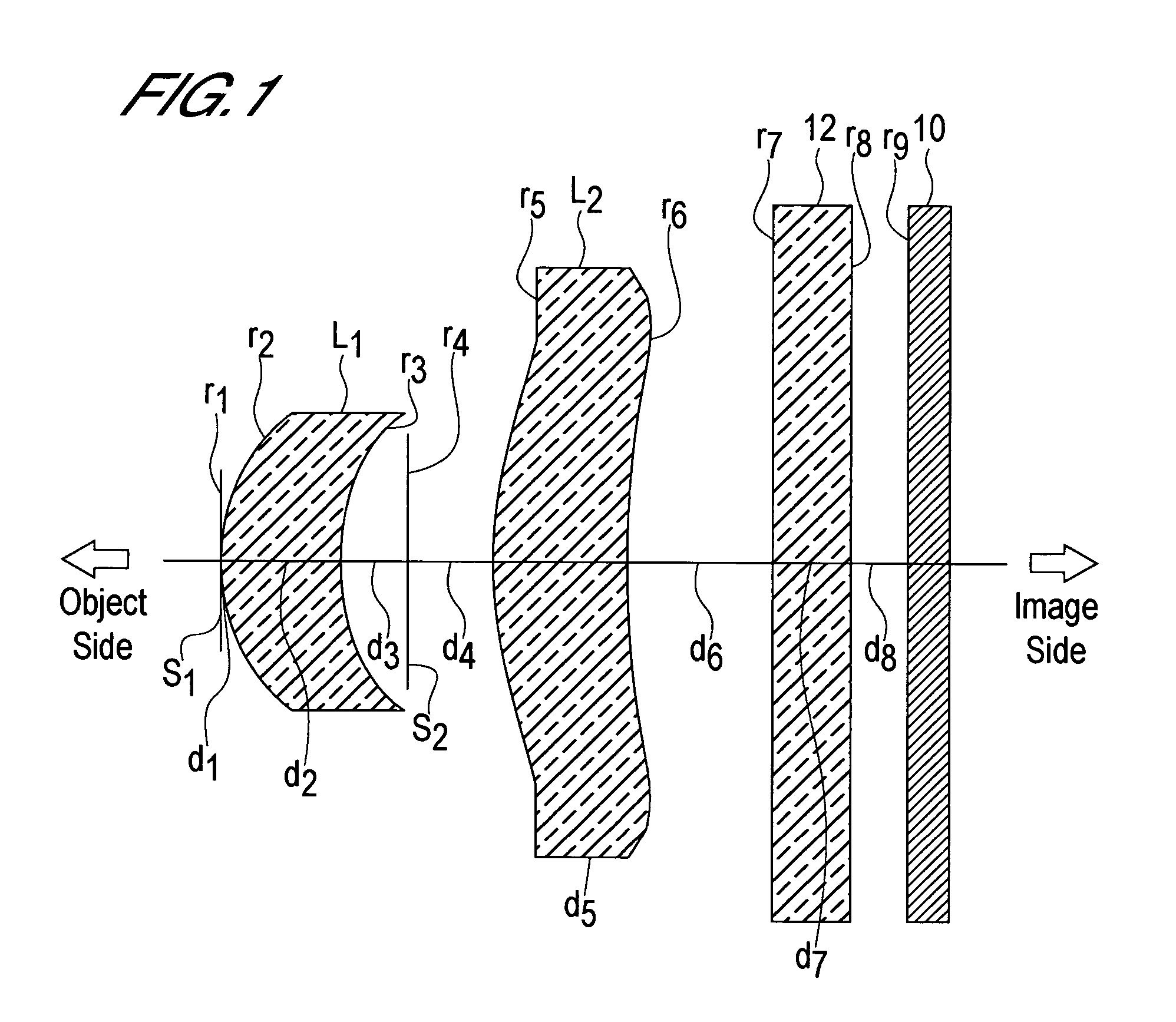Imaging lens
a technology of imaging lens and lens body, which is applied in the field of imaging lens, can solve the problems of insufficient compactness of lens system, inability to design a sufficiently compact lens system, and inability to enlarge the optical length of the lens, so as to achieve satisfactory image, short lens optical length, and satisfactory brightness.
- Summary
- Abstract
- Description
- Claims
- Application Information
AI Technical Summary
Benefits of technology
Problems solved by technology
Method used
Image
Examples
embodiment 1
[0084](A) The focal length f1 of the first lens L1 is 1.63 mm.
[0085](B) The focal length f2 of the second lens L2 is 1.74 mm.
[0086](C) The combined focal length f for all lenses is 1.0 mm.
[0087](D) The back focus bf is 0.463 mm.
[0088](E) The optical length d is 1.193 mm.
[0089](F) The interval D2 between the first lens L1 and the second lens L2 is 0.2738 mm.
[0090](G) The F-number Fno is 3.0.
[0091]Hence:
f1 / f2=1.63 / 1.74=0.9368
bf / f=0.463 / 1.0=0.463
d / f=1.193 / 1.0=1.193
D2 / f=0.2738 / 1.0=0.2738
Fno=3.0
[0092]Therefore the lens system of Embodiment 1 satisfies all of the following condition equations (1) through (5).
0.3<f1 / f2<1.0 (1)
0.4<bf / f<0.5 (2)
1.0<d / f<1.3 (3)
0.12<D2 / f<0.30 (4)
2.0no<4.0 (5)
[0093]As indicated in Table 1, the aperture diaphragm S1 is provided at the position of the first surface r2 (the object-side surface) of the first lens L1. The second diaphragm S2 is provided at the position 0.1217 mm (d3=0.1217 mm) behind the second surface r3 of the first l...
embodiment 2
[0100](A) The focal length f1 of the first lens L1 is 1.36 mm.
[0101](B) The focal length f2 of the second lens L2 is 2.48 mm.
[0102](C) The combined focal length f for all lenses is 1.0 mm.
[0103](D) The back focus bf is 0.454 mm.
[0104](E) The optical length d is 1.102 mm.
[0105](F) The interval D2 between the first lens L1 and the second lens L2 is 0.1727 mm.
[0106](G) The F-number Fno is 3.0.
[0107]Hence:
f1 / f21.36 / 2.48=0.5484
bf / f=0.454 / 1.0=0.454
d / f=1.102 / 1.0=1.102
D2 / f=0.1727 / 1.0=0.1727
Fno=3.0
[0108]Therefore the lens system of Embodiment 2 satisfies all of the following condition equations (1) through (5).
0.3<f1 / f2<1.0 (1)
0.4<bf / f<0.5 (2)
1.0<d / f<1.3 (3)
0.12<D2 / f<0.30 (4)
2.0no<4.0 (5)
[0109]As indicated in Table 2, the aperture diaphragm S1 is provided at the position of the first surface r2 (the object-side surface) of the first lens L1. The second diaphragm S2 is provided at the position 0.1007 mm (d3=0.1007 mm) behind the second surface r3 of the first le...
embodiment 3
[0116](A) The focal length f1 of the first lens L1 is 1.29 mm.
[0117](B) The focal length f2 of the second lens L2 is 2.89 mm.
[0118](C) The combined focal length f for all lenses is 1.0 mm.
[0119](D) The back focus bf is 0.462 mm.
[0120](E) The optical length d is 1.079 mm.
[0121](F) The interval D2 between the first lens L1 and the second lens L2 is 0.1435 mm.
[0122](G) The F-number Fno is 3.0.
[0123]Hence:
f1 / f2=1.29 / 2.89 0.4464
bf / f=0.462 / 1.0=0.462
d / f=1.079 / 1.0=1.079
D2 / f=0.1435 / 1.0=0.1435
Fno=3.0
[0124]Therefore the lens system of Embodiment 3 satisfies all of the following condition equations (1) through (5).
0.3<f1 / f2<1.0 (1)
0.4<bf / f<0.5 (2)
1.0<d / f<1.3 (3)
0.12<D2 / f<0.30 (4)
2.0no<4.0 (5)
[0125]As indicated in Table 3, the aperture diaphragm S1 is provided at the position of the first surface r2 (the object-side surface) of the first lens L1. The second diaphragm S2 is provided at the position 0.0861 mm (d3=0.0861 mm) behind the second surface r3 of the first l...
PUM
 Login to View More
Login to View More Abstract
Description
Claims
Application Information
 Login to View More
Login to View More - R&D
- Intellectual Property
- Life Sciences
- Materials
- Tech Scout
- Unparalleled Data Quality
- Higher Quality Content
- 60% Fewer Hallucinations
Browse by: Latest US Patents, China's latest patents, Technical Efficacy Thesaurus, Application Domain, Technology Topic, Popular Technical Reports.
© 2025 PatSnap. All rights reserved.Legal|Privacy policy|Modern Slavery Act Transparency Statement|Sitemap|About US| Contact US: help@patsnap.com



